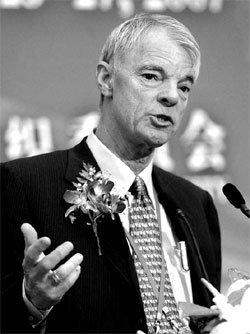|

Michael Spence: China's economy will sustain its fast growth for at least two more decades.
|
China has been in a high growth mode since it started economic reforms in the late 70s. Its almost three decades of high growth is the longest among the 11 high-growth economies in the world and part of "a recent, post-World War II phenomenon". And the Chinese economy will sustain its fast growth for at least two more decades.
These are the words of no less a person than Stanford University professor Michael Spence, who shared the 2001 Nobel Prize forEconomicswith Columbia University professor and former senior vice-president ofWorld BankJoseph E. Stiglitz and University of California (Berkeley) professor George A. Akerlof.
In the post-War period, 11 economies have recorded high growth, with eight of them being in Asia: the Chinese mainland, Hong Kong, Taiwan, Singapore, Indonesia, South Korea, Malaysia and Thailand, Spence says. Going bygross domestic product(GDP) figures, "high growth" means above 7 percent expansion, and an economy is said to have "sustained growth" if it keeps growing for 25 years or more. Growth at such rates produces very substantial changes in income and wealth.
The Chinese mainland is not only the latest example of a high-growth economy, but it has also seen the fastest and largest increase in growth in terms of population, says the senior fellow of Hoover Institution, a top US think tank. India too has attracted a lot of attention because it is entering a period of high growth.
"Though each growth model is different, they share certain features," Spence told the Shanghai Forum 2007 at the Fudan University in late May. "In all cases, there is a functioningmarket economywith its price signals, incentives, decentralization and enough definition of private property ownership to enable investment."
|

A labourer installs a steel bar at a construction site in Kunming, capital of southwest China's Yunnan Province, June 8, 2007. China's almost three decades of high growth is the longest among the 11 high-growth economies in the world, says Stanford University professor Michael Spence. [Reuters]
|
The high levels of savings and investments both in the public and private sectors, resource mobility and rapid urbanization are the important characteristics of China's high growth, says Spence, who is also the chairman of the independent Commission on Growth and Development. The commission was set up last year to focus on growth and poverty reduction in developing countries. China's saving rate between 35 to 45 percent is among the highest despite the relatively low level of income of its people. Resource mobility has generated new productive employment to absorb surplus labor in a country where 15-20 million people move from the rural areas to the cities every year.
The most important feature of sustained high growth is that it leverages the demand and resources of the global economy, says Spence. All cases of sustained high growth in the post-War period have integrated into the global economy because exports act as a major high-growth driver.
"The systematic reduction of barriers to trade and investment in the last 55 years and the dramatic fall in costs of transportation, information and communications technologies have combined to raise the level of that integration. It is the combined effect of these trends that has made the global economy an increasingly powerful source of potential growth."
